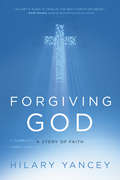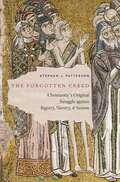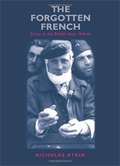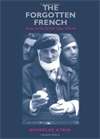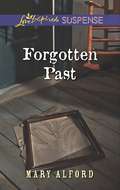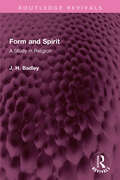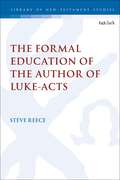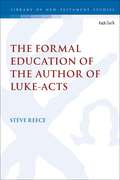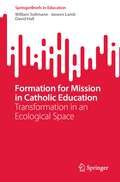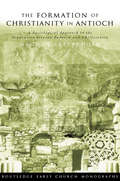- Table View
- List View
Forgiving and Remembering in Northern Ireland: Approaches to Conflict Resolution
by Graham SpencerAs Northern Ireland moves from conflict to tentative peace, ongoing violence and unrest underline that the province remains a turbulent and troubled society. This book brings together contributions from those directly affected by the Troubles who work for peace and reconciliation in their communities. The issues they raise are given poignancy and power by being grounded in human experience, and provide a necessary starting point for exploring the tensions which arise in the struggle to reconcile forgiveness and remembrance in order to create a more purposeful and meaningful future. They have important implications not only for Northern Ireland but also for other societies emerging from conflict.
Forgiving and Remembering in Northern Ireland: Approaches to Conflict Resolution
by Graham SpencerAs Northern Ireland moves from conflict to tentative peace, ongoing violence and unrest underline that the province remains a turbulent and troubled society. This book brings together contributions from those directly affected by the Troubles who work for peace and reconciliation in their communities. The issues they raise are given poignancy and power by being grounded in human experience, and provide a necessary starting point for exploring the tensions which arise in the struggle to reconcile forgiveness and remembrance in order to create a more purposeful and meaningful future. They have important implications not only for Northern Ireland but also for other societies emerging from conflict.
Forgiving God: A Story of Faith
by Hilary YanceyA young mother's life is forever changed and her faith in God is broken when her son in diagnosed with complex physical disabilities. Restore and grow your faith as you read about Hilary Yancey's personal journey back to God.Three months into her pregnancy with her first child, Hilary Yancey received a phone call that changed everything. As she learned the diagnosis-cleft lip and palate, a missing right eye, possible breathing complications-Hilary began to pray in earnest. Even in the midst of these findings, she prayed that God would heal her son. God could do a miracle unlike anything she had seen. Only when Hilary held her baby, Jack, in her arms for the first time did she realize God had given her something drastically different than what she had demanded. Hilary struggled to talk to God as she sat for six weeks beside Jack's crib in the NICU. She consented to surgeries and learned to care for a breathing tube and gastronomy button. In her experience with motherhood Hilary had become more familiar with the sound of her son's heart monitor than the sound of his heartbeat. Later, during surgeries and emergency trips back to the hospital with her crying, breathless boy, Hilary reproached the stranger God had become. Jack was different. Hilary was not the mother she once imagined. God was not who Hilary knew before. But she could not let go of one certainty-she could see the image of Christ in Jack's face. Slowly, through long nights of wrestling and longer nights of silence, Hilary cut a path through her old, familiar faith to the God behind it. She discovered that it is by walking out onto the water, where the firm ground gives way, that we can find him. And meeting Jesus, who rises with his scars to proclaim new life, is never what you once imagined.
The Forgotten Creed: Christianity's Original Struggle against Bigotry, Slavery, and Sexism
by Stephen J. PattersonLong before the followers of Jesus declared him to be the Son of God, Jesus taught his followers that they too were the children of God. This ancient creed, now all but forgotten, is recorded still within the folds of a letter of Paul the Apostle. Paul did not create this creed, nor did he fully embrace it, but he quoted it and thus preserved it for a time when it might become important once again. This ancient creed said nothing about God or Christ or salvation. Its claims were about the whole human race: there is no race, there is no class, there is no gender. This is the story of that first, forgotten creed, and the world of its begetting, a world in which foreigners were feared, slaves were human chattel, and men questioned whether women were really human after all. Into this world the followers of Jesus proclaimed: "You are all children of God. There is no Jew or Greek, no slave or free, no male and female, for you are all one." Where did this remarkable statement of human solidarity come from, and what, finally, happened to it? How did Christianity become a Gentile religion that despised Jews, condoned slavery as the will of God, and championed patriarchy? Christian theologians would one day argue about the nature of Christ, the being of God, and the mechanics of salvation. But before this, in the days when Jesus was still fresh in the memory of those who knew him, the argument was a different one: how can human beings overcome the ways by which we divide ourselves one from another? Is solidarity possible beyond race, class, and gender?
The Forgotten Creed: Christianity's Original Struggle against Bigotry, Slavery, and Sexism
by Stephen J. PattersonLong before the followers of Jesus declared him to be the Son of God, Jesus taught his followers that they too were the children of God. This ancient creed, now all but forgotten, is recorded still within the folds of a letter of Paul the Apostle. Paul did not create this creed, nor did he fully embrace it, but he quoted it and thus preserved it for a time when it might become important once again. This ancient creed said nothing about God or Christ or salvation. Its claims were about the whole human race: there is no race, there is no class, there is no gender. This is the story of that first, forgotten creed, and the world of its begetting, a world in which foreigners were feared, slaves were human chattel, and men questioned whether women were really human after all. Into this world the followers of Jesus proclaimed: "You are all children of God. There is no Jew or Greek, no slave or free, no male and female, for you are all one." Where did this remarkable statement of human solidarity come from, and what, finally, happened to it? How did Christianity become a Gentile religion that despised Jews, condoned slavery as the will of God, and championed patriarchy? Christian theologians would one day argue about the nature of Christ, the being of God, and the mechanics of salvation. But before this, in the days when Jesus was still fresh in the memory of those who knew him, the argument was a different one: how can human beings overcome the ways by which we divide ourselves one from another? Is solidarity possible beyond race, class, and gender?
The forgotten French
by Nicholas AtkinIt is assumed that those French in Britain during World War II - Dunkirk refugees; servicemen; Vichy consular officials; colonists - were supporters of De Gaulle. This study examines the hopes and fears of these communities: how they fitted into British life and how the British viewed them.
The forgotten French (PDF)
by Nicholas AtkinIt is assumed that those French in Britain during World War II - Dunkirk refugees; servicemen; Vichy consular officials; colonists - were supporters of De Gaulle. This study examines the hopes and fears of these communities: how they fitted into British life and how the British viewed them.
Forgotten Memories: Forgotten Memories Fugitive At Large Surviving The Storm (SWAT: Top Cops #4)
by Laura ScottFORGETTING THE PAST CAN BE DEADLY…
Forgotten Millions: The Modern Jewish Exodus from Arab Lands
by Malka Hillel ShulewitzThe untold story of how the once flourishing Jewish communities in the Arab Middle East have virtually disappeared. The Forgotten Millions tells the story of the modern Jewish exodus from the Arab lands against the backdrop of the historical presence of Christian and other minorities. The Jewish presence in this area-present-day Morocco, Algeria, Tunisia, Libya, Egypt, the Lebanon, Syria, Iraq and Yemen-preceded the rise of Islam by more than a thousand years. These Jewish communities often played a leading role in the development of the region, particularly as recorded in the Cairo Genizah, with which the book begins. In 1948 when the state of Israel was declared, there were an estimated 870,000 Jews in the region. By 1986, a generation later, the ancient Jewish peoples had virtually disappeared. Only about 20,000 remain, mainly in North Africa. Of these refugees, some 200,000 opted for the Americas and other Western countries; the majority migrated to Israel, where today they and their progeny comprise over 40 per cent of the population. What happened to trigger the transfer of whole communities? Why did this historic movement and the tragedy that preceded it fail to leave their impress either on the contemporary annals of the Jewish people or on the consciousness of the free world? The Forgotten Millions probes the reasons for this silence.
Forgotten Past: Undercover Marriage Collateral Damage Forgotten Past (Mills And Boon Love Inspired Suspense Ser.)
by Mary AlfordLOST MEMORIES
The Forgotten Reign of the Emperor Jovian (363-364): History and Fiction
by Jan Willem DrijversThe Forgotten Reign of the Emperor Jovian (363-364): History and Fiction offers a new assessment of the Roman emperor's brief rule. A former imperial bodyguard, Jovian reinvigorated the Roman Empire militarily, administratively, and religiously. More than an imperial footnote, the years 363-364 restored the Roman empire after the failed reign of Julian. Jovian returned to the policies of Constantius II and Constantine the Great and his political legacy continued to endure with his successors Valentinian I and Valens, especially in the realm of religion. Jan Willem Drijvers' newest edition tracks the intricacies of Jovian's election, offers a novel evaluation of his peace agreement with Shapur II, and examines Jovian's self-representation. For an emperor who ruled only eight months, Jovian had an unexpected and surprising afterlife. In the rarely studied and largely unknown historical fiction piece The Julian Romance, Jovian is presented as the ideal Christian emperor and a new Constantine. In comparison with other sources, the Syriac Romance also offers a surprising and different perspective on his personal associations and reign. The Forgotten Reign challenges readers to rethink Jovian's reign and other imperial figures largely forgotten by history. Ultimately, the book reveals the legacy of Jovian's role in Roman-Persian relations and the positioning of Edessa in the late antique world of Christendom.
The Forgotten Reign of the Emperor Jovian (363-364): History and Fiction
by Jan Willem DrijversThe Forgotten Reign of the Emperor Jovian (363-364): History and Fiction offers a new assessment of the Roman emperor's brief rule. A former imperial bodyguard, Jovian reinvigorated the Roman Empire militarily, administratively, and religiously. More than an imperial footnote, the years 363-364 restored the Roman empire after the failed reign of Julian. Jovian returned to the policies of Constantius II and Constantine the Great and his political legacy continued to endure with his successors Valentinian I and Valens, especially in the realm of religion. Jan Willem Drijvers' newest edition tracks the intricacies of Jovian's election, offers a novel evaluation of his peace agreement with Shapur II, and examines Jovian's self-representation. For an emperor who ruled only eight months, Jovian had an unexpected and surprising afterlife. In the rarely studied and largely unknown historical fiction piece The Julian Romance, Jovian is presented as the ideal Christian emperor and a new Constantine. In comparison with other sources, the Syriac Romance also offers a surprising and different perspective on his personal associations and reign. The Forgotten Reign challenges readers to rethink Jovian's reign and other imperial figures largely forgotten by history. Ultimately, the book reveals the legacy of Jovian's role in Roman-Persian relations and the positioning of Edessa in the late antique world of Christendom.
Forgotten Women: The Leaders (Forgotten Women)
by Zing TsjengSelected for the Evening Standard present gift guide of the year'To say this series is "empowering" doesn't do it justice. Buy a copy for your daughters, sisters, mums, aunts and nieces - just make sure you buy a copy for your sons, brothers, dads, uncles and nephews, too.' - indy100'Here's to no more forgotten women.' Evening StandardThe women who shaped and were erased from our history.The Forgotten Women series will uncover the lost histories of the influential women who have refused over hundreds of years to accept the hand they've been dealt and, as a result, have formed, shaped and changed the course of our futures. The Leaders weaves together 48* unforgettable portraits of the true pioneers and leaders who made huge yet unacknowledged contributions to history, including:Grace O'Malley, the 16th century Irish pirate queenSylvia Rivera, who spearheaded the modern transgender rights movementAgent 355, the unknown rebel spy who played a pivotal role in the American RevolutionNoor Inayat Khan, who went undercover to spy for the French Resistance and became Nazi enemy no. 1Amina of Zazzau, the formidable ancient Muslim warrior queen of Northern NigeriaChapters including Rebels; Warriors; Rulers; Activists and Reformers shine a spotlight on the rebellious women who defied the odds, and the opposition, to change the world around them. *The number of Nobel-prize-winning women.
The Forgotten Years of Kurdish Nationalism in Iran (Minorities in West Asia and North Africa)
by Abbas ValiThis book investigates the forgotten years of Kurdish nationalism in Iran, from the fall of the Kurdish republic to the advent of the Iranian revolution. An original and path-breaking investigation of the period, it sheds light not only on the historical specificity of the phenomenon of nationalism in exile, but also on the political processes and practices defining the development of Kurdish nationalism in the post-revolutionary era. Although nationalist landmarks such as the Kurdish republic in 1946 and the resurgence of the movement in the revolutionary conjuncture of 1978-79 have attracted the attention of historians and social scientists in recent years, little is known about the three decades of Kurdish nationalism in exile between these two events. This analysis draws on contemporary poststructuralist theory to question the concept of the minority in democratic and constitutional theory, arguing that it is an effect of the discursive linkage between sovereign power and the dominant ethnic-linguistic identity in the nation-state. This text will appeal to a wide academic audience ranging from the fields of Kurdish, Iranian and Middle East Studies to ethnicity, nationalism, government, and political science.
Form and Spirit: A Study in Religion (Routledge Revivals)
by J.H. BadleyFirst published in 1951, Form and Spirit deals with two primary questions regarding religion- a) the nature of religion as a permanent need in human life, and its relation to the cults and creeds in which it has been embodied, and b) whether what is admittedly a crying need of our time can be met by the revival of religious forms which have lost their hold. An attempt is made to trace the evolution of religion, and a brief survey is given of the development of the chief world religions. The object is not to show that any of these can be accounted ‘truer’ than the rest but rather to see what were the reasons for the forms that they have taken, and what elements and tendencies are common to them, as throwing light both on the meaning of religion and on the needs of man's spiritual nature. This is an essential read for general readers interested in religion.
Form and Spirit: A Study in Religion (Routledge Revivals)
by J.H. BadleyFirst published in 1951, Form and Spirit deals with two primary questions regarding religion- a) the nature of religion as a permanent need in human life, and its relation to the cults and creeds in which it has been embodied, and b) whether what is admittedly a crying need of our time can be met by the revival of religious forms which have lost their hold. An attempt is made to trace the evolution of religion, and a brief survey is given of the development of the chief world religions. The object is not to show that any of these can be accounted ‘truer’ than the rest but rather to see what were the reasons for the forms that they have taken, and what elements and tendencies are common to them, as throwing light both on the meaning of religion and on the needs of man's spiritual nature. This is an essential read for general readers interested in religion.
The Formal Education of the Author of Luke-Acts (The Library of New Testament Studies)
by Steve ReeceSteve Reece proposes that the author of Luke-Acts was trained as a youth in the primary and secondary Greek educational curriculum typical of the Eastern Mediterranean during the Roman Imperial period, where he gained familiarity with the Classical and Hellenistic authors whose works were the focus of study. He makes a case for Luke's knowledge of these authors internally by spotlighting the density of allusions to them in the narrative of Luke-Acts, and externally by illustrating from contemporary literary, papyrological, and artistic evidence that the works of these authors were indeed widely known in the Eastern Mediterranean at the time of the composition of Luke-Acts, not only in the schools but also among the general public.Reece begins with a thorough examination of the Greek educational system during the Hellenistic and Roman Imperial periods, emphasizing that the educational curriculum was very homogeneous, at least at the primary and secondary levels, and that children growing up anywhere in the Eastern Mediterranean could expect to receive quite similar educations. His close examination of the Greek text of Luke-Acts has turned up echoes, allusions, and quotations of several of the very authors that were most prominently featured in the school curriculum: Homer, Aesop, Euripides, Plato, and Aratus. This reinforces the view that Luke, along with other writers of the New Testament, lived in a cultural milieu that was influenced by Classical and Hellenistic Greek literature and that he was not averse to invoking that literature when it served his theological and literary purposes.
The Formal Education of the Author of Luke-Acts (The Library of New Testament Studies)
by Steve ReeceSteve Reece proposes that the author of Luke-Acts was trained as a youth in the primary and secondary Greek educational curriculum typical of the Eastern Mediterranean during the Roman Imperial period, where he gained familiarity with the Classical and Hellenistic authors whose works were the focus of study. He makes a case for Luke's knowledge of these authors internally by spotlighting the density of allusions to them in the narrative of Luke-Acts, and externally by illustrating from contemporary literary, papyrological, and artistic evidence that the works of these authors were indeed widely known in the Eastern Mediterranean at the time of the composition of Luke-Acts, not only in the schools but also among the general public.Reece begins with a thorough examination of the Greek educational system during the Hellenistic and Roman Imperial periods, emphasizing that the educational curriculum was very homogeneous, at least at the primary and secondary levels, and that children growing up anywhere in the Eastern Mediterranean could expect to receive quite similar educations. His close examination of the Greek text of Luke-Acts has turned up echoes, allusions, and quotations of several of the very authors that were most prominently featured in the school curriculum: Homer, Aesop, Euripides, Plato, and Aratus. This reinforces the view that Luke, along with other writers of the New Testament, lived in a cultural milieu that was influenced by Classical and Hellenistic Greek literature and that he was not averse to invoking that literature when it served his theological and literary purposes.
The Formation and Significance of the Christian Biblical Canon: A Study in Text, Ritual and Interpretation
by Tomas BokedalThis book offers a fresh cross-disciplinary approach to the current discussion on the Christian canon formation process. By carefully integrating historical, hermeneutical and theological aspects to account for the emergence of the canon, it seeks to offer a more comprehensive picture of the canon development than has previously been achieved. The formation and continuous usage of the Christian biblical canon is here viewed as an act of literary preservation and actualization of the church's apostolic normative tradition - 'the Scriptures and the Lord' - addressing, first of all, the church, but also the wider society. In order to grasp the complex phenomenon of the biblical canon, the study is divided into four parts, focusing respectively on linguistic and effective-historical, textual and material, performative, and ideational aspects of the canon. Attention is given to the scribal nomina sacra convention, the codex format, oral and written Gospel, early Christian liturgical praxis and the Rule of Faith. Bokedal argues that the canon was formed in a process, with its own particular intention, history, and direction. Throughout the study, history and theology, past and present are considered alongside each other. By using a Gadamerian hermeneutics of tradition, the reader's attention is directed to historical dimensions of the canon and its interpretative possibilities for our time. The notion of effective history (Wirkungsgeschichte), as well as the interaction between text, community and reader are crucial to the argument. The canonical text as text, its interpretation and ritual contextualization are highlighted as unifying elements for the communities being addressed.
Formation for Mission in Catholic Education: Transformation in an Ecological Space (SpringerBriefs in Education)
by William Sultmann Janeen Lamb David HallThis book arose from commissioned research by the National Catholic Education Commission (NCEC) on the alignment and effectiveness of 'A Framework for Formation for Mission in Catholic Education' (NCEC, 2017). It articulates contemporary best practice, and traces the experience of the Catholic Church in pursuing formation as integral to mission. This book also reviews and reports on formation within the context of the Catholic school. Its research validates ‘The Framework’ in Catholic education, and provides a complementary narrative for enhancing formation alignment and effectiveness, specifically with a focus on the Catholic school, but also with implications for formation in the wider context of ministry applications.This book is developed based on three questions, which also serve as thematic chapters that structure the narrative: what is the context and culture in which formation occurs; how is formation presented and enacted within the Australian context; and how can the understanding and practice of formation be advanced beyond its context and culture, policy, programs and ‘The Framework’ principles.
The Formation of Ch'an Ideology in China and Korea: The Vajrasamadhi-Sutra, a Buddhist Apocryphon
by Robert E. Buswell Jr.This book is a translation and study of the Vajrasamadhi-Sutra and an examination of its broad implications for the development of East Asian Buddhism. The Vajrasamadhi-Sutra was traditionally assumed to have been translated from Sanskrit, but some modern scholars, principally in Japan, have proposed that it is instead an indigenous Chinese composition. In contrast to both of these views, Robert Buswell maintains it was written in Korea around A.D. 685 by a Korean adept affiliated with the East Mountain school of the nascent Chinese Ch'an tradition. He thus considers it to be the oldest work of Korean Ch'an (or Son, which in Japan became known as the Zen school), and the second-oldest work of the sinitic Ch'an tradition as a whole. Buswell makes his case for the scripture's dating, authorship, and provenance by placing the sutra in the context of Buddhist doctrinal writings and early Ch'an literature in China and Korea. This approach leads him to an extensive analysis of the origins of Ch'an ideology in both countries and of the principal trends in the sinicization of Buddhism. Buddhism has typically been studied in terms of independent national traditions, but Buswell maintains that the history of religion in China, Korea, and Japan should be treated as a whole.Originally published in 1989.The Princeton Legacy Library uses the latest print-on-demand technology to again make available previously out-of-print books from the distinguished backlist of Princeton University Press. These editions preserve the original texts of these important books while presenting them in durable paperback and hardcover editions. The goal of the Princeton Legacy Library is to vastly increase access to the rich scholarly heritage found in the thousands of books published by Princeton University Press since its founding in 1905.
The Formation of Christendom (Princeton Classics #121)
by Judith HerrinA groundbreaking history of how the Christian “West” emerged from the ancient Mediterranean worldIn this acclaimed history of Early Christendom, Judith Herrin shows how—from the sack of Rome in 410 to the coronation of Charlemagne in 800—the Christian “West” grew out of an ancient Mediterranean world divided between the Roman west, the Byzantine east, and the Muslim south. Demonstrating that religion was the period’s defining force, she reveals how the clash over graven images, banned by Islam, both provoked iconoclasm in Constantinople and generated a distinct western commitment to Christian pictorial narrative. In a new preface, Herrin discusses the book’s origins, reception, and influence.
The Formation of Christendom (Princeton Classics #121)
by Judith HerrinA groundbreaking history of how the Christian “West” emerged from the ancient Mediterranean worldIn this acclaimed history of Early Christendom, Judith Herrin shows how—from the sack of Rome in 410 to the coronation of Charlemagne in 800—the Christian “West” grew out of an ancient Mediterranean world divided between the Roman west, the Byzantine east, and the Muslim south. Demonstrating that religion was the period’s defining force, she reveals how the clash over graven images, banned by Islam, both provoked iconoclasm in Constantinople and generated a distinct western commitment to Christian pictorial narrative. In a new preface, Herrin discusses the book’s origins, reception, and influence.
The Formation of Christianity in Antioch: A Social-Scientific Approach to the Separation between Judaism and Christianity
by Magnus ZetterholmMagnus Zetterholm uses theoretical insights from the social sciences to deal with the complex issues raised by the parting of Judaism and Christianity, and the accompanying rise of Christian anti-Semitism in ancient Antioch. Unlike previous attempts to solve this problem have focused mainly on ideology, Zetterholm's excellent study emphasizes the interplay between sociological and ideological elements. For students of religious studies, classical studies, history and social science, this will give leverage and knowledge in the pursuit of their course studies.
The Formation of Christianity in Antioch: A Social-Scientific Approach to the Separation between Judaism and Christianity
by Magnus ZetterholmMagnus Zetterholm uses theoretical insights from the social sciences to deal with the complex issues raised by the parting of Judaism and Christianity, and the accompanying rise of Christian anti-Semitism in ancient Antioch. Unlike previous attempts to solve this problem have focused mainly on ideology, Zetterholm's excellent study emphasizes the interplay between sociological and ideological elements. For students of religious studies, classical studies, history and social science, this will give leverage and knowledge in the pursuit of their course studies.

